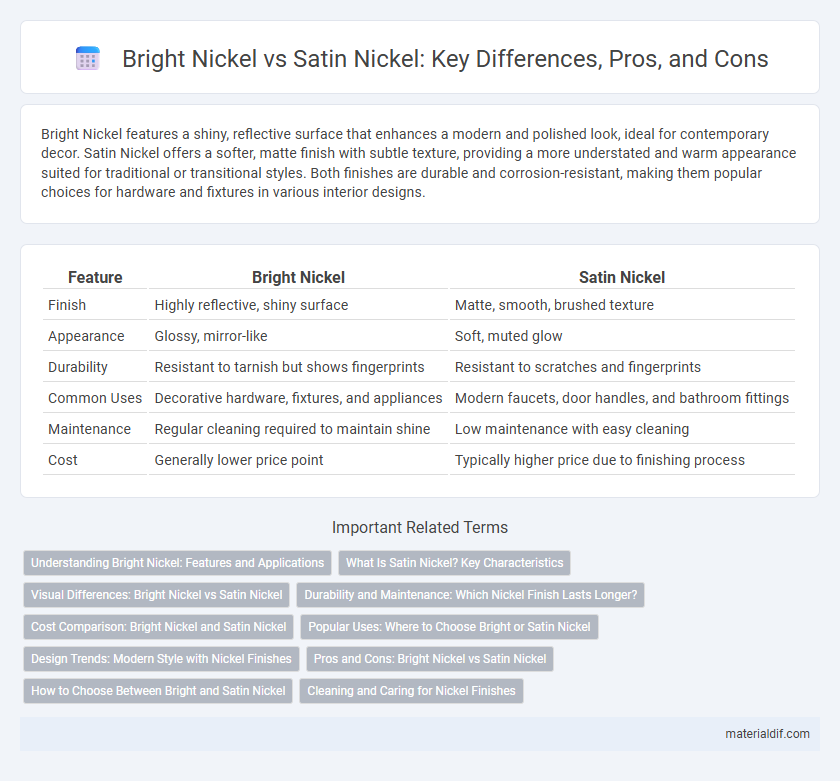Bright Nickel features a shiny, reflective surface that enhances a modern and polished look, ideal for contemporary decor. Satin Nickel offers a softer, matte finish with subtle texture, providing a more understated and warm appearance suited for traditional or transitional styles. Both finishes are durable and corrosion-resistant, making them popular choices for hardware and fixtures in various interior designs.
Table of Comparison
| Feature | Bright Nickel | Satin Nickel |
|---|---|---|
| Finish | Highly reflective, shiny surface | Matte, smooth, brushed texture |
| Appearance | Glossy, mirror-like | Soft, muted glow |
| Durability | Resistant to tarnish but shows fingerprints | Resistant to scratches and fingerprints |
| Common Uses | Decorative hardware, fixtures, and appliances | Modern faucets, door handles, and bathroom fittings |
| Maintenance | Regular cleaning required to maintain shine | Low maintenance with easy cleaning |
| Cost | Generally lower price point | Typically higher price due to finishing process |
Understanding Bright Nickel: Features and Applications
Bright nickel plating offers a smooth, reflective surface that enhances corrosion resistance and durability, making it ideal for decorative and industrial applications. Its high surface brightness improves aesthetics on consumer electronics, automotive parts, and household fixtures. This plating process also provides excellent adhesion for subsequent coatings, ensuring long-lasting protection.
What Is Satin Nickel? Key Characteristics
Satin nickel is a type of nickel finish characterized by its smooth, non-reflective surface that offers a muted, matte appearance. Unlike bright nickel, which has a shiny and highly reflective texture, satin nickel provides a subtle, modern look with a soft silver-gray tone that resists fingerprints and smudges. This finish is popular for hardware and fixtures due to its durability and ability to complement a wide range of decor styles without the glare of a polished surface.
Visual Differences: Bright Nickel vs Satin Nickel
Bright nickel features a highly reflective, mirror-like finish that enhances modern and sleek aesthetics, while satin nickel exhibits a soft, matte surface with a subtle sheen, offering a more muted and understated appearance. The smooth and glossy texture of bright nickel highlights sharper contrasts and reflections, making it ideal for contemporary designs, whereas satin nickel's diffused light effect reduces glare and fingerprints, lending itself well to traditional or casual settings. Visual differentiation between the two finishes lies primarily in their sheen intensity and surface texture, impacting their suitability for various interior design themes and lighting conditions.
Durability and Maintenance: Which Nickel Finish Lasts Longer?
Bright nickel offers a highly reflective, glossy finish that is more prone to showing fingerprints and scratches, requiring frequent cleaning and maintenance. Satin nickel, with its matte, brushed texture, effectively hides smudges and wear, making it more durable and easier to maintain over time. In terms of longevity, satin nickel generally lasts longer in high-traffic areas due to its resistance to tarnishing and reduced visibility of minor surface damage.
Cost Comparison: Bright Nickel and Satin Nickel
Bright nickel plating typically costs more than satin nickel due to its shiny, polished finish that requires additional polishing and buffing processes, increasing production expenses. Satin nickel, with its matte, brushed appearance, involves less labor-intensive finishing steps, resulting in lower overall costs. Consumers often choose satin nickel for cost-efficiency without sacrificing durability or corrosion resistance.
Popular Uses: Where to Choose Bright or Satin Nickel
Bright nickel finish is ideal for modern kitchens and bathrooms, offering a shiny, reflective surface often used on faucets, cabinet handles, and light fixtures to create a polished look. Satin nickel, with its matte and muted texture, is popular in high-traffic areas like door hardware, hinges, and drawer pulls, providing durability and an elegant, understated appeal that hides fingerprints and smudges. Professionals recommend bright nickel for contemporary designs emphasizing clean lines and satin nickel for traditional or transitional styles seeking subtle sophistication.
Design Trends: Modern Style with Nickel Finishes
Bright nickel finishes offer a sleek, reflective surface that complements modern design trends by enhancing light and creating a polished, contemporary look. Satin nickel provides a softer, muted sheen ideal for minimalist and industrial styles, adding subtle sophistication without glare. Designers increasingly select nickel finishes for their versatility and durability, ensuring modern spaces maintain both style and functionality.
Pros and Cons: Bright Nickel vs Satin Nickel
Bright nickel offers a highly reflective, mirror-like finish that enhances modern and sleek designs, providing excellent corrosion resistance but may show fingerprints and scratches more easily. Satin nickel features a matte, brushed surface that better conceals fingerprints and wear, making it ideal for high-traffic areas, though it may require more maintenance to preserve its uniform appearance. Choosing between bright and satin nickel depends on aesthetic preference and the balance between surface visibility and durability needed for the application.
How to Choose Between Bright and Satin Nickel
Choosing between bright nickel and satin nickel depends on the desired aesthetic and application environment. Bright nickel offers a highly reflective, mirror-like finish that enhances modern, polished looks, making it ideal for decorative hardware and fixtures where shine is a focal point. Satin nickel provides a muted, matte appearance with a soft, brushed texture that hides fingerprints and scratches, making it suitable for high-traffic areas or traditional settings requiring subdued elegance.
Cleaning and Caring for Nickel Finishes
Bright nickel finishes require gentle cleaning with a mild soap solution and a soft cloth to maintain their reflective shine, avoiding abrasive materials that can cause scratches. Satin nickel surfaces are more forgiving but benefit from regular dusting and the use of a damp cloth to preserve their matte texture without dulling the finish. Both nickel types should be protected from harsh chemicals and ammonia-based cleaners to prevent tarnishing and discoloration.
Bright Nickel vs Satin Nickel Infographic

 materialdif.com
materialdif.com